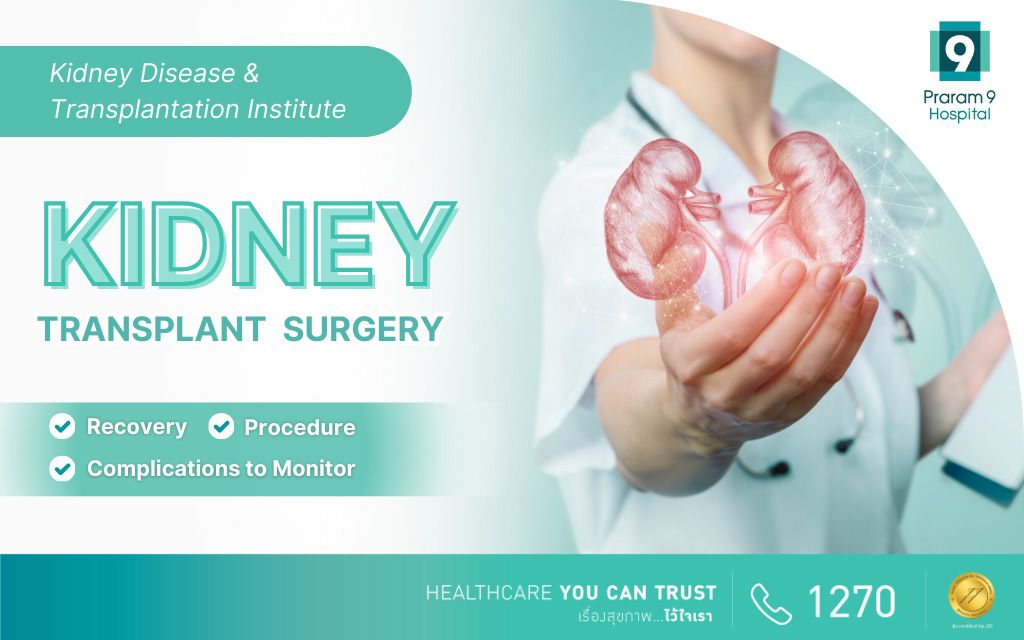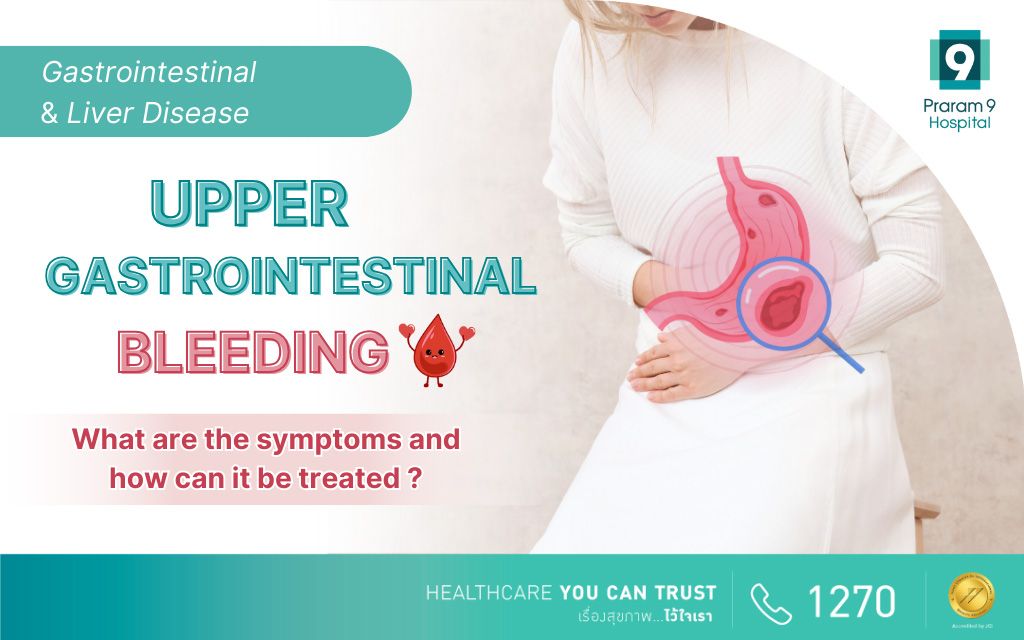Health Articles
Knowledge
Kidney Transplant Surgery Procedure, Recovery, and Complications to Monitor
SUTHANIT LAOWALERT, M.D.

Kidney transplantation is a surgical procedure that involves transplanting a kidney from a living donor or a donor who is brain-dead into a patient with chronic kidney failure, without removing the patient’s existing kidneys. The new kidney takes over the function of the damaged kidneys. The success rate of kidney transplantation is relatively high, and after the procedure, patients can experience a significant improvement in their quality of life. Therefore, kidney transplantation is considered the best treatment for chronic kidney failure.
However, it is a major surgery with complex procedures. Before the operation, the donor kidney must be carefully matched to the recipient with chronic kidney failure, ensuring compatibility of blood and tissue between the donor and recipient to prevent rejection. Once a suitable kidney is found, the surgeon will perform the transplant on the patient.
During and after the surgery, patients may face the risk of serious complications, so they must be closely monitored by a medical team. After the surgery, patients need to recover in the hospital to ensure that the new kidney is functioning properly and effectively.
Table of contents
- Success rate of kidney transplantation
- Sources of Donor Kidneys
- Kidney Transplantation from a Living Donor
- Health and Lifestyle After Kidney Donation Surgery
- Kidney Transplantation from a Deceased Donor
- Kidney Transplant Surgery Procedure
- Postoperative Recovery After Kidney Transplant Surgery
- Monitoring the Function of the New Kidney
- What is Kidney Rejection?
- Other Complications After Kidney Transplant Surgery
- Conclusion
Success Rate of Kidney Transplantation
With current advancements, kidney transplantation has a relatively high success rate and is considered an effective treatment for chronic kidney failure. Statistical data shows that kidney transplant surgeries generally have a high success rate. Overall, within the first year post-surgery, transplants from living donors have a slightly higher success rate compared to transplants from brain-dead donors. However, both types of kidney transplants have very high success rates, as detailed below:
- Success rate of kidney transplants from living donors: 95–98%
- Success rate of kidney transplants from brain-dead donors: 85–90%
Sources of Donor Kidneys
Kidneys used for transplantation in patients with chronic kidney failure come from two sources:
- Living Donors: These include immediate relatives, blood-related relatives, or spouses. Living donors must meet the established eligibility criteria.
- Deceased Donors: Kidneys donated by individuals who are brain-dead are allocated by the Thai Red Cross Society. (This is available only to Thai nationals)
Kidney Transplantation from a Living Donor
As mentioned earlier, kidneys used for transplantation patients with end-stage chronic kidney failure can be donated by immediate relatives, blood-related relatives, or spouses. After donating a kidney, the donor can live a normal life because humans are born with two kidneys. Donating one kidney does not significantly impact the donor’s ability to live a healthy life, as a single kidney is sufficient to filter waste and excess water from the body and perform other kidney functions effectively.
Research to date has shown that living with only one kidney does not significantly increase the risk of developing other kidney diseases later in life compared to individuals who have not donated a kidney. Any potential risks are minimal, such as slight increase in blood pressure or protein leakage in the urine. Additionally, the life expectancy of kidney donors is equivalent to that of the general population.
Pre-Surgery Preparations
Before the kidney is removed from the living donor, the donor must stay in the hospital one day before the surgery. The purposes of this are:
- To allow the medical team to evaluate the donor’s physical and mental readiness for surgery.
- To address any uncertainties or obstacles, ensuring that the surgery is safe for the donor. If needed, the surgery may be canceled or postponed.
- To provide the donor an opportunity to discuss any concerns or questions with the medical team, helping them gain confidence and ensuring they get adequate rest before the procedure.
Kidney Removal Surgery from a Living Donor
There are two types of surgery techniques used to remove a kidney from a living donor:
Open Donor Nephrectomy
- A long incision of about 5–7 inches is made on the side of the body.
- The surgery is performed under general anesthesia and takes 2–3 hours.
- Post-surgery, the donor will need to recover in the hospital for about 7 days.
- Stitches are usually removed on the 7th day after surgery.
- The donor can generally resume normal activities within 4–6 weeks after surgery.
Laparoscopic Donor Nephrectomy
- A smaller incision of about 3–4 inches is made near the navel. The kidney is removed using laparoscopic techniques, results in a smaller incision, less blood loss, and reduced postoperative pain.
- The surgery is performed under general anesthesia and takes 1–2 hours.
- Post-surgery, the donor will need to recover in the hospital for about 2–3 days.
- The donor can generally resume normal activities within 2–4 weeks after surgery.
Health and Lifestyle After Kidney Donation Surgery
After donating a kidney, it is essential for the donor to take care of their health during the recovery period, both in the hospital and at home, as well as maintain long-term health. This includes undergoing regular kidney function tests and general health check-ups, at least annually, to ensure overall well-being. These annual check-ups are generally recommended by doctors for everyone, not just kidney donors, as they help monitor health, prevent diseases, and detect any conditions before they become severe.
Hospital Recovery After Kidney Donation
- Post-Surgery Recovery: After the surgery, the donor will stay in the recovery room until fully awake and stable before being moved to a patient room. An IV line and a urinary catheter will be in place.
- Pain Management: If the donor experiences pain at the surgical site, pain-relief injections will be administered as prescribed by the doctor.
- Diet and Activity: The donor can start sipping water on the first day after surgery, gradually increasing food intake. It is recommended to sit up, stand, take deep breaths, and start walking as soon as possible to prevent complications related to the lungs and respiratory system. Early walking can help speed up recovery.
- Hospital Stay: Kidney donation surgery generally has few complications, and donors can usually leave the hospital within 7 days. Stitches are typically removed on the 7th day after surgery.
- Possible Complications: Although rare, complications such as infection, bleeding, lung collapse, urinary tract infection, bloating, intestinal issues, and severe pain at the surgical site can occur. These complications are treatable but may extend the hospital stay.
- Mortality Rate: The global mortality rate after kidney donation is extremely low, approximately 0.03% (3 cases out of 10,000).
Home Recovery After Kidney Donation
- Follow-up Appointments: After being discharged from the hospital, the doctor will schedule a follow-up appointment within 1–2 weeks to check the surgical site and kidney function.
- Diet and Activity: Donors should maintain a healthy diet, engage in light household activities, and can usually return to work within 2–4 weeks after surgery.
- Activity Restrictions: Avoid lifting objects heavier than 6 kilograms and refrain from straining the abdominal muscles to prevent damage to the surgical site for 4 weeks.
- Returning to Normal Life: Donors can typically return to their normal lifestyle within 6 weeks after surgery.
- Sexual Activity: Sexual activity can be resumed whenever the donor feels physically ready.
Post-Donation Kidney Function Monitoring
- First Month: During the first month after surgery, the donor should visit the doctor to have kidney function and overall health checked.
- Annual Check-Ups: After the initial recovery, it is recommended to have a check-up every 12 months at a minimum.
The medical team at the Kidney and Transplant Institute at Praram 9 Hospital is always available to provide consultation and answer any questions, recognizing and honoring the compassion and generosity of kidney donors who save lives.
Kidney Transplantation from a Deceased Donor
After removing the kidney from a deceased donor, it is stored in a sterile plastic bag at 4°C to preserve it. The kidney is transported to the transplant operating room as quickly as possible, along with crucial information such as the donor’s sex, age, cause of death, the side of the kidney (left or right), anatomical condition, any lesions or pathologies, the number of blood vessels, and the time when the blood vessels were clamped. This time marks the beginning of the kidney’s cold ischemic time, which is the period during which the kidney is deprived of blood supply.
The kidney can be preserved for up to 72 hours from the cold ischemic time. However, in practice, transplantation is usually performed within 24 hours to ensure that the transplanted kidney functions effectively and quickly. Upon arrival at the transplant operating room, the medical team will assess the condition of the kidney and proceed with the transplantation to the recipient.
Kidney Transplant Surgery Procedure
Kidney transplant surgery involves meticulous preparation and planning before, during, and after the procedure to ensure the optimal function of the transplanted kidney and the overall success of the treatment.
Hospital Admission 24 Hours Before Kidney Transplant Surgery
Patients with chronic kidney failure must be admitted to the hospital within 24 hours before the surgery to allow the medical team to prepare as follows:
- Medical History and Physical Assessment: Specialized physicians conduct an evaluation of the patient’s overall health and mental state.
- Nursing, Nutritional, and Pharmaceutical Care: The patient’s care is coordinated by a team of nurses, dietitians, and pharmacists.
- Laboratory Tests: Blood and urine samples are tested in the lab.
- Chest X-ray: To assess lung and heart health.
- Electrocardiogram (ECG): To monitor the patient’s heart rhythm and detect any potential issues.
- Body Preparation: The patient must bathe with a special antiseptic soap and shave the surgical area to ensure cleanliness.
- Intravenous Fluids: Administered to maintain hydration and electrolyte balance.
- Dialysis: May be required based on the levels of waste in the blood and the patient’s weight, with a final assessment on when the last dialysis session should be performed.
- Immunosuppressive Medication: The patient will receive the first dose of immunosuppressive drugs either orally or intravenously to prevent organ rejection.
Kidney Transplant Surgery Procedure
- Anesthesia: The anesthesiologist administers general anesthesia to ensure the recipient is asleep and pain-free during the surgery.
- Incision: The surgeon makes an incision in the lower abdomen, typically just above the groin on one side.
- Transplantation: The donated kidney is placed into the recipient’s abdominal cavity. The surgeon connects the new kidney’s blood vessels to the recipient’s arteries and veins, and attaches the ureter (the tube that carries urine from the kidney) to the bladder.
- Old Kidneys: The patient’s existing kidneys are usually left in place unless there’s a medical reason to remove them. The new kidney is simply added.
- Drainage Tube: A drainage tube is inserted into the abdominal cavity to remove any excess blood or lymphatic fluid that may accumulate after the surgery.
The entire kidney transplant surgery typically takes about 4 hours.
Postoperative Recovery After Kidney Transplant Surgery
Kidney transplant surgery requires careful planning and preparation before, during, and after the procedure to ensure the new kidney functions optimally and the treatment is successful.
Hospital Stay Within 24 Hours Before the Transplant
- After the surgery, the patient is closely monitored in the intensive care unit (ICU) for about 5 to 7 days. Once the patient’s condition stabilizes, they are transferred to a regular hospital ward for continued care.
- When the patient wakes up after surgery, they will have several tubes attached to their body, which are typically necessary for 2 to 3 days post-surgery. These tubes are positioned as follows
- The recovery period varies for each patient, with numerous tests conducted to monitor the function of the new kidney and to detect any signs of rejection. In some cases, dialysis might be necessary after the surgery.
- This is usually a temporary measure during the initial phase as the new kidney adjusts to the recipient’s body and begins to function properly.
Monitoring the Function of the New Kidney
The healthcare team will monitor the function of the new kidney using several tests:What is Kidney Rejection?
What is Kidney Rejection?
Kidney rejection occurs when the body’s immune system attacks the new kidney. This is why patients must take immunosuppressive medications daily. Rejection can happen gradually or suddenly.
Normally, the immune system responds to pathogens, cancer cells, or foreign substances entering the body. It also reacts against transplanted organs, including the new kidney, as if it were a foreign entity. To prevent rejection, doctors and transplant teams administer immunosuppressive drugs and educate patients about the side effects of these medications, while maintaining a balance in immune system function.
Signs of Kidney Rejection
If a patient experiences any of the following symptoms, they should immediately inform their doctor or transplant team:
- Fever or flu-like symptoms
- Fatigue or unusual weakness
- Swelling in areas like the eyelids, hands, or feet
- Cloudy urine, painful urination, or discomfort during urination
- Urine output less than 1 liter per day despite normal fluid intake
- Dark yellow or orange urine, or blood in the urine
Prompt treatment when signs of rejection are first noticed can allow the new kidney to regain function. Delayed treatment may make it too late to address the issue effectively. Therefore, kidney transplant recipients must monitor for signs of rejection and seek timely medical attention.
Types of Kidney Rejection
Kidney rejection is classified into three types based on timing:
- Hyperacute Rejection: Occurs immediately and is severe, usually resulting in immediate loss of the kidney. It happens within the first few hours after transplantation and requires immediate removal of the kidney.
- Acute Rejection: Can occur within the first 1-2 weeks after transplantation, commonly seen within the first 1-6 months. It can occur at any time throughout the life of the transplanted kidney, even 5-10 years later.
- Chronic Allograft Nephropathy: A slow, progressive form of rejection that develops months to years after transplantation, leading to gradual deterioration of the kidney function.
Patients experiencing rejection must receive timely treatment. A kidney biopsy is often performed to determine the type and severity of rejection, which allows for appropriate and swift treatment.
Other Complications After Kidney Transplant Surgery
In addition to kidney rejection, there are other potential complications that can occur after kidney transplant surgery, including:
- Infections: These can affect various areas, such as the lungs, urinary tract, surgical wounds, abdomen, liver, intestines, brain, or bloodstream.
- Surgical Complications: Issues such as bleeding at the incision site or within the abdomen, blood vessel blockage, blood vessel congestion, or ureteral obstruction or leakage.
- Anesthesia Complications: Problems related to anesthesia, including collapsed lung, pneumonia, or respiratory failure.
- Cardiac Complications: Heart-related issues such as coronary artery disease, heart failure, or arrhythmias.
- Gastrointestinal Complications: Problems in the digestive system, including stomach ulcers, gastrointestinal bleeding, or infections in the stomach or intestines.
- Cerebrovascular Issues: Conditions like stroke or bleeding in the brain.
- Recurrence of Pre Existing Kidney Conditions: Reemergence of past kidney diseases such as IgA nephropathy or focal segmental glomerulosclerosis (FSGS).
- Undiagnosed Conditions: Potential infections or hidden diseases that may not be immediately diagnosed.
While most complications can be treated effectively, some may pose serious risks and potentially be life-threatening. Monitoring and timely intervention are crucial to managing these risks.
Conclusion
Kidney transplantation is a major surgery that requires careful and thorough preparation, both for the kidney donor—whether living or from a deceased donor—and for the recipient, to ensure effective treatment outcomes and quality of life. The process involves several steps, including detailed compatibility testing of blood and tissue between donor and recipient to ensure the kidney is suitable for the patient with chronic kidney failure. The surgery is performed by a specialized surgical team to remove the kidney from the donor and transplant it into the recipient. After the surgery, the patient will be hospitalized for recovery, with close monitoring by the medical team to assess the risk of kidney rejection and other potential complications, and ensure the new kidney functions effectively.
Praram 9 hospital is recognized for its Kidney Disease and Transplant institute and has successfully performed over 1,000 kidney transplants, earning Praram 9 hospital as the Top private hospital in Thailand for kidney transplants.
You can consult a doctor from anywhere through video calls.
Our hospital has received the Joint Commission International accreditation (JCI) since 2010 and a special accreditation from JCI for our Kidney Disease and Transplant Institute.















